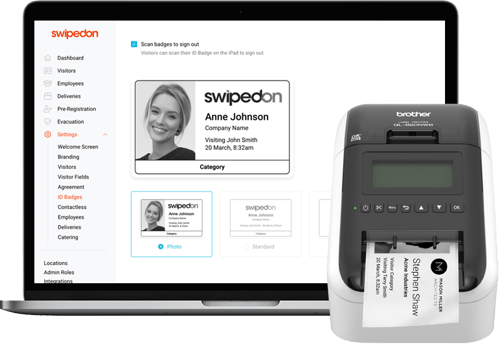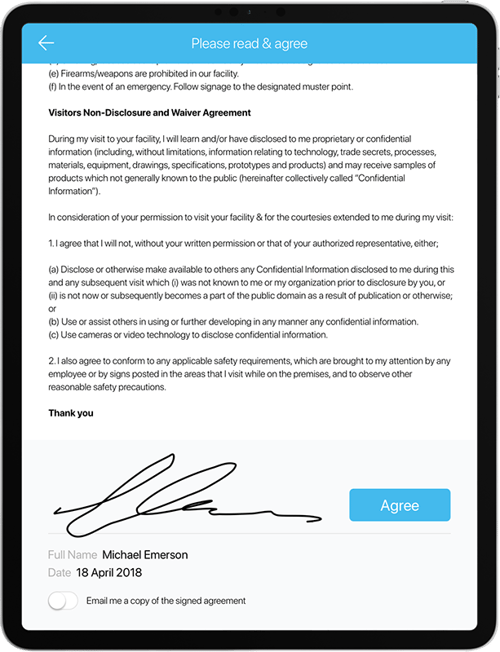7 Tips for Writing an Exceptional Visitor Policy

A visitor policy provides a framework for employees and visitors to your company. It helps staff members and receptionists understand the right procedures to handle visitors, and gives guests clear guidelines on how to act and where they’re allowed to go. Below we’ll explore the fundamentals that every visitor policy needs in order to keep staff and visitors safe, while protecting your company from legal and security risks, theft, sabotage, or worse.
1. Establish a Chain of Command and Authorization Procedures
Before writing your visitor policy, you should establish a clear chain of command. If you have a large office, select a team member from front-office staff as head of visitor management. You should also ensure that all receptionists understand their visitor-related responsibilities.
After allocating roles and responsibilities, you’ll need to clarify authorization procedures. For example, all visitors need to show a form of government ID and fill in their details. They then sign the visitor policy and other required documents on a visitor management app. If your workplace is a high-risk environment like a construction site, receptionist staff can brief visitors on what they need to wear or bring onsite.
These procedures guide guests on what they can and can’t do, and how they should behave when entering the facility.
2. Highlight Restricted Areas
Most workplaces have restricted areas that contain confidential information, intellectual property, or contain highly-dangerous and toxic chemicals. That’s why you need to highlight which areas are available for different guests in your visitor policy. For example, recreational and conference rooms may be open to all guests, but the research and development areas may be off-limits.
As William Deutsch notes, writing for The Balance, without a visitor policy there is “the risk of theft (intellectual or physical), sabotage, and even terrorism.” In fact, the Commission on the Theft of American Intellectual Property estimates that the annual costs from intellectual property theft range from $225 billion to $600 billion.
While the threat of sabotage, terrorism, or intellectual property theft is low, the event of any one of these activities is extremely costly for any organization. It’s better to be prepared and prevent these circumstances.
3. Keep a Record of Visitors
Front-desk staff must be aware of all the visitors currently in the facility. The easiest way to keep track of visitors for receptionists is to sign in every visitor with a visitor management system. This way, authorized personnel can keep track of every guest entering and exiting the office.
Maintaining a record of visitors is advantageous, especially when it comes to evacuations. While workplace emergencies are not common, they happen. An average of 3,340 fires occurred in offices between 2007 and 2011, resulting in many injuries and fatalities. A visitor record can help staff members keep track of visitors in the event of an emergency or evacuation.
4. Categorize Different Types of Visitors
Many organizations have different types of visitors entering their building. For example, on a construction site, you can have contractors, investors, and even marketing and sales staff on site.
You’ll need to track and make visible the different types of guests entering the facility and consider different procedures, access, and surveillance required for each type of visitor. It’s best to have different sign-in procedures for each, and ensure their visitor type is printed clearly on their visitor ID badge. This way, staff can easily identify the visitor and their level of access.

5. Include Any Taping, Recording, or Non-Disclosure Policies
If your workplace stores a lot of confidential information, intellectual property, or cutting-edge research and development, you’ll need to protect it from your guests. In your visitor policy, you should include restrictions regarding recording in the workplace as well as the appropriate use of your office’s Wi-Fi. To protect your organization, you can also include a non-disclosure agreement and require all guests to sign the document before they can enter the facility.
According to Kathy Close, a contributing writer at BizJournal, “Visitors also need to be told of consequences of ‘noncompliance’ to your policy’s rules. This includes immediate removal from the premises and visitor privileges revoked. Employees who act as escorts may also need to be reminded of the rules.”
It’s always a good idea to have a clause on the consequences of noncompliance in your visitor policy. It’s a great way to deter bad behaviour and ensure visitors don’t put themselves, staff members, and the company at risk.

6. Include Additional Relevant Policies
Your workplace or facility may be dangerous, contain highly-sensitive information, or require a lot of care and preparation to go onsite. If this is the case, you may need to include other related policies, as well.
For example, Atlanta’s Centers for Disease Control and Prevention (CDC) requires all visitors to not only sign in and wear their visitor badge, but they also search for any hand-carried items. The CDC will X-ray visitors and run them through their metal detection system as well. They include this information in their visitor policy so guests are not caught off guard and know what to expect. They also have additional security-related policies for different types of visitors entering their facility.
7. Educate Staff Members
After drafting up a visitor policy, educate and inform staff members on the new policy and their roles in visitor safety and management.
You should have a general procedure to walk through the process of onboarding different types of guests with each receptionist. With SwipedOn’s visitor management system, you can streamline the visitor sign-in process by including the visitor policy, other policies, and all required documents using an all-in-one app. This way, your staff can focus on the important details when authorizing guests and leave the administrative work to the app.
A solid visitor policy is essential for all organizations, regardless of industry and size. It helps receptionists understand their key responsibilities when it comes to visitor management, and provides clear guidelines for visitors entering the facility. To implement an exceptional visitor policy, you really need to pair it with a visitor management app. It will eliminate the administrative headache and help staff members authorize and track guests more effectively.
Photo credit: Philipp Katzenberger



-929560-edited-003563-edited.jpg)





 Germany - Deutsch
Germany - Deutsch